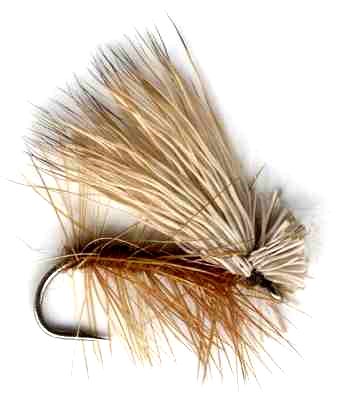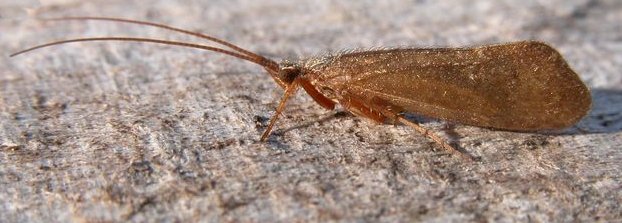Brown Elk Hair Caddis (Sedge) Fly
When fishing from the lake edge, river bank or when floating in a boat, I love the sight of adult caddis skittering over the water surface and trout bow-waving after them. It is one of those enduring images of summer fly fishing.

CADDIS FLY PATTERNS. Hook size 10 12 14 16 18 20 - $US each
During high summer, with temperatures near the 80 degree mark, there is normally nothing to be seeing moving on the water. In the evening the picture is very different. You will be able to spot trout surfacing for their bed time snack.
In early summer caddis larvae who have spent the winter in their protective tubular cases pupate. When they are ready to hatch they chew through the outer protective layer of their casing and begin their perilous journey to the water surface. Many species of caddis hatch in the surface film but some swim towards the shore and crawl out onto bankside vegetation to hatch. The newly hatched adults now head for cover as soon as they are fit. Those that have hatched on the water try to use their long sweptback wings for the first time to escape to safety. This is when they leave a tell-tale V shaped wake in the water that attracts the trout’s attention. The game is on. Will the newly hatched adult caddis be able to become airborne before the pursuing trout gains enough speed to catch it.

When a hatch of caddis is going on, you must match the size and color of the new adults from your fly box and try to imitate the take-off attempt of the caddis on the water surface, whilst producing a similar wake. Be prepared for an exciting evenings fly fishing as you spot the movement of pursuing hungry trout behind your fly. Do not be tempted to slow down as it may spook the fish as this would be considered an un-natural movement. The real insects would just fly off not slow down waiting to be eaten.
Deep Wading with a Brown Elk Hair Caddis fly
The evening rise provides testing time for fly fisherman for several reasons. The main one is the difficulty in finding a taking pattern when trout are on a particular fly. This is notoriously problematic when the Blue Winged Olive BWO is around. Another nice problem is posed by the quick rhythm of hatches. The limestone river I fish regularly has a varied fly-life and you can see several different species emerging in the two hours before darkness on a summer evening. This is why I like to deep wade so I can see what is happening easier.
On my last visit I saw spurwings, BWOs, caenis and at least three species of dark bodied caddis. Each with a quite thick flush hatch, and the sequences was complicated by numbers of sherry spinners and caddis returning to the water to lay eggs.
At one point I had three trout in station ahead of me and I could clearly see two snapping at the caddis, while the other was taking emerging BWOs. Being able to distinguish the trout feeding on small sedges allowed me to select them as easier targets. I tied on a Brown Elk Hair Caddis fly which they devoured.
Finding out what the fish are taking and spotting separate species of fly and their stages of development, add enormously to the pleasure of fishing for rising trout. To the extent that the angler who cannot wade deep is deprived of this information, he is frustrated in the first need of imitative fly-fishing – knowing what is on the menu.
Tactically, almost all the advantages are with deep wader. He is much nearer his fish than a bank fisher can normally afford to be or a thigh wader can usually manage. He can see more clearly the currents which carry his fly, and is able to spot the little eddies which are snares for the unwary.
Reading currents has to be a highly developed skill, especially on shallow summer rivers, when weeds cause all sorts of fast lanes and diversions. Again it is obvious that the closer one is, the more accurate one can cast.
A shorter cast is more accurate than a long one. It allows a longer drift and is less likely to be affected by drag. These are considerable advantages. Also to be placed in the balance is the latitude in casting which the deep wader’s position gives. In upstream presentation, he has the liberty of moving the rod in a more horizontal plane than a bank angler’s position allows and so can avoid alarming his quarry.
The short cast is also the more pleasant one to use. The deep wader can fish a lighter rod than can the bank angler and a balance of tackle more appropriate to the delicacy of river trouting. On my limestone river I can fish a 2 1/2oz 8ft rod with a No.5 line on most evenings for dry fly work. From the bank I would need a 9ft rod carrying a No.6 line, the length for clearing obstructions on the back cast and the weight for distance.
Despite its merits, deep wading in trout streams is an emotive issue. In some stretches of water it is banned. Use high quality
chest waders
with felt soles on the boots for extra grip and check the water with a
good quality
folding fishing wading staff
. Always think of your saftey.

Fly Fisherman Al Troth designed the popular Elk Hair Caddis dry fly
CUSTOMER'S COMMENT
One must go with what is going on at the time, however I should mention I fish streams in Western USA (mainly Utah, Wyoming, Montana, Idaho, California) and if I was to pick a failsafe fly it would be the elk hair caddis in the 20 to 24 range. Willian E Schlater, California, USA
CUSTOMER'S COMMENT
Fished for about an hour with BWO's only one hit despite loads of fish rising. I then changed to one of your brown caddis and landed 6 straight away. Sam Crampton, West Malling. Kent, England
CUSTOMER'S COMMENT
Fishing on the St Mary River in South Eastern British Columbia in low and clear water conditions your Elk Hair Caddis were the go to flies when others failed. The Cutts were especially skittish but went to these flies fished dry and high. Gary Eastman. BC


